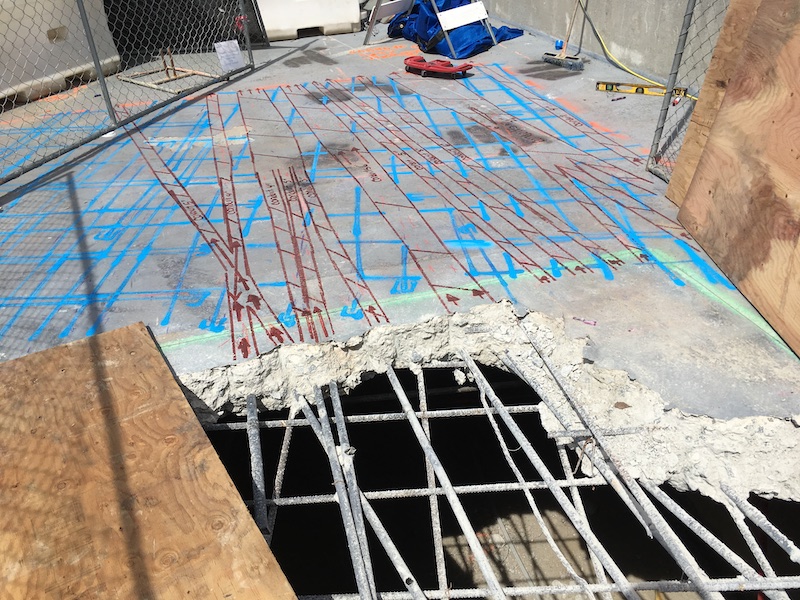Exploring the Depths: A Comprehensive Overview to Concrete Scanning and Its Diverse Applications
In the world of building and construction and facilities development, the meticulous procedure of concrete scanning holds an essential role in making certain the architectural honesty and safety of projects. As technology continues to evolve, the applications of concrete scanning have actually expanded much past plain surface-level evaluations.
Value of Concrete Scanning
Understanding the importance of concrete scanning is essential in making certain the security and stability of frameworks throughout building and restoration jobs. Concrete scanning utilizes advanced modern technologies such as ground-penetrating radar (GPR) and electromagnetic induction to detect embedded items, voids, or other anomalies within concrete structures - RainierGPR Concrete Scanning. By conducting detailed scans before drilling, reducing, or coring into concrete, construction groups can stay clear of unintended damage to important architectural components like rebar, channels, or post-tension cords. This proactive strategy not just avoids pricey repairs and task delays however also enhances total building safety by mitigating the risk of architectural failings or collapses as a result of jeopardized stability.
Additionally, concrete scanning plays a critical role in making sure conformity with building ordinance and regulations that mandate the defense of existing structural elements throughout building and construction tasks. By precisely drawing up the interior composition of concrete, scanning innovations enable construction experts to make educated decisions that maintain the architectural stability and resilience of buildings and infrastructure projects. Basically, the importance of concrete scanning lies in its ability to protect both the structural stability and the employees included in building ventures.
Technologies Used in Concrete Scanning
Concrete scanning depends on sophisticated innovations such as ground-penetrating radar (GPR) and electromagnetic induction to accurately detect embedded things and abnormalities within concrete frameworks. Ground-penetrating radar operates by discharging high-frequency electro-magnetic waves into the concrete. When these waves encounter different products or voids within the concrete, they get better to the surface area, permitting the GPR system to create a thorough subsurface image. This modern technology is especially effective in finding rebar, post-tension cable televisions, avenues, and various other objects installed in concrete.
Electromagnetic induction, on the various other hand, functions by producing electro-magnetic areas around a concrete structure with a transmitter coil. When steel objects exist within the concrete, they interfere with these magnetic fields, creating eddy currents to move with the metal. By gauging the adjustments in the magnetic fields with a receiver coil, the system can identify the area of metallic items in the concrete.
These advanced technologies play a vital function in non-destructive testing, guaranteeing the security and stability of concrete frameworks in various markets.
Applications in Building Sector
Within the building market, concrete scanning innovation finds diverse applications that improve job efficiency and safety. Additionally, concrete scanning is utilized for situating spaces, such as air pockets or areas of wear and tear within concrete, which can jeopardize the total toughness of a structure. Concrete scanning plays an important function in high quality control by validating the thickness of concrete covers over support, guaranteeing conformity with design specs and criteria.

Security Advantages of Concrete Scanning
In the world of construction safety and security, the execution of concrete scanning technology provides an extremely important benefit in preemptively recognizing possible dangers and fortifying architectural integrity. By using innovative scanning techniques such as ground-penetrating radar (GPR) and electro-magnetic induction, building groups can precisely locate rebar, post-tension wires, avenues, and other surprise things within concrete frameworks. This aggressive method significantly reduces the threat of unintentional strikes during drilling, reducing, or coring tasks, consequently protecting against pricey problems, injuries, and task hold-ups.
In addition, concrete scanning boosts worker security by supplying real-time details about the structural condition of concrete elements. This data enables building and construction professionals to examine the integrity of existing structures, identify deterioration or defects, and make educated decisions concerning repair work and upkeep treatments. By attending to possible safety worries immediately, concrete scanning contributes to developing a protected working atmosphere and reducing the probability of structural failures or accidents on building and construction websites. Eventually, the safety and security advantages of concrete scanning not just guard lives and properties but Your Domain Name additionally support industry requirements for top quality and reliability.
Future Trends in Concrete Scanning
Emerging developments in scanning modern technology are poised to revolutionize the area of concrete examination and analysis. By utilizing the power of AI, these systems can assess huge quantities of information accumulated throughout scanning processes to provide even more thorough and precise understandings right into the condition of concrete structures.
Another considerable pattern is the advancement of even more user-friendly and mobile scanning gadgets. Miniaturization of scanning devices permits simpler access to confined areas and remote locations, making assessments more comprehensive and reliable. Furthermore, improvements in wireless communication modern technologies enable real-time data transfer and evaluation, assisting in quicker decision-making procedures.
Additionally, there is an expanding concentrate on sustainability in concrete scanning innovations - RainierGPR Concrete Scanning. Manufacturers are progressively integrating environment-friendly materials and energy-efficient attributes right into their devices to decrease ecological impact. These future trends are set to improve the performance, accuracy, and sustainability of concrete scanning techniques, shaping the sector's future landscape
Conclusion
In verdict, concrete scanning plays a critical duty in the building sector by guaranteeing the safety and effectiveness of different tasks. As modern technology developments, the future of concrete scanning holds appealing developments for boosting building procedures.
